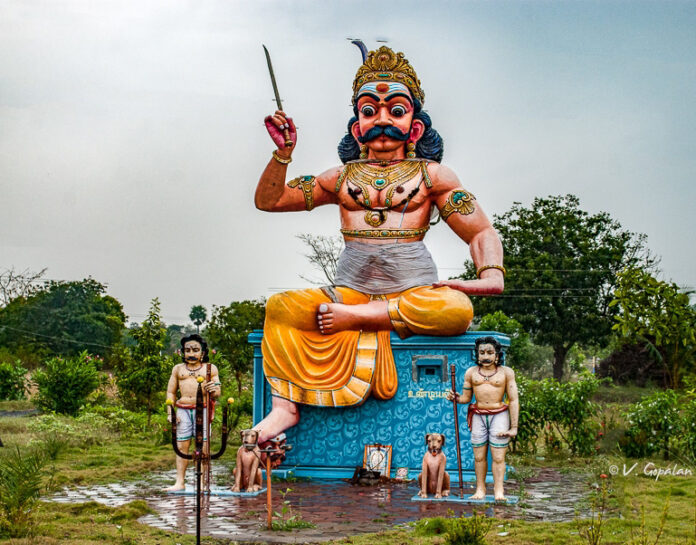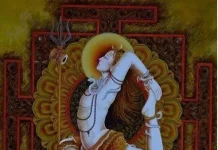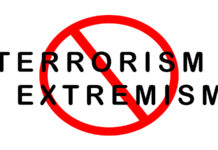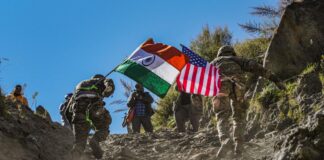The day before, I was returning from Puducherry after the Pondicherry Literature Festival (PLF). As the National Highway construction was going on, the driver took an alternate route through a longer village road. It turned out to be a nostalgic blessing. On the way one could see small, beautiful temples that promised solitude. Naturally, we stopped at different places to spend some time and click some pictures.
By Aravindan Neelakandan
On or near the boundaries of the villages in Tamil Nadu, and most probably in other states of India too, there stand the Guardian Deities (Kaval Theivangal). These Deities protect the villages.
They identify those who enter the villages with evil intentions. They either drive them away or show them such a fierceness that they eschew their evil intentions, reform and settle in the village.
Usually, the Guardian Deity will also be accompanied by Parivara Devatas – attendant divine forms and there would also be a temple to another Deity – usually a Goddess.
At Setharaapatti village boundary, through which our car passed, there stands a temple for the Sapta-Matrika – the seven mothers. One can see the Sapta-Matrika near the water bodies. One can see them in the cave paintings of Bhimbetka. One can see them on Harappan seals. They are also in many temples throughout India. One can also see them in almost every Indian village.
From Sapta-Sindhu to Sapta-Matrika there is a spiritual continuum that binds the nation. They are one of those ‘strong but invisible threads’ that reinforce the cultural unity of India, as even Jawaharlal Nehru could not deny.
In this particular Sapta-Matrika temple also stands the fierce form of the village guardian Deity. And on His two sides stand two of His assistants. Who are they? They are police men with the Khaki pants and shirts, rifles and along with them stand two police dogs.
This is not an isolated depiction. You can see police men depicted along with the Guardian Deity in many villages in Tamil Nadu. They are shown with the same iconography and they would stand the same way, throughout the state.
Is it just fanciful imagination or just a thanksgiving gesture to some otherwise would-be-forgotten policemen who guarded the village against some villainous calamity? The phenomenon is too widespread and too uniform for such a localised explanations, though in many cases they can’t be ruled out either.
So, what could be the reason, a deeper reason?
The reason could be rooted in Swarajya.
The concept of a police force was a modern concept that was introduced by the British colonialists for their benefit. The police force was part of the state mechanism for the protection of the state. They were dehumanised machine hogs. They obeyed a colonial Government. They were alienated from the people and often were made to work against their own people.
They maintained law-and-order in the way the colonial State demanded – the law-and-order that would benefit the Empire. They replaced the usual community-based protection, that was organic to the social structure of Bharat. At the same time, the police force was well-structured and well-networked. They were here to stay.
Even after independence the same police force continued with the same structure, the same value-system of obedience to the State Machine and the same alienation. So, obedience to political bosses, police brutality and corruption became systemic in India, as it was in most post-colonial states. In all these countries, the police system gravitated towards becoming brutal and corrupt.
While in the states of colonisers the police was meant to keep order, serve the upper classes of the society and also to serve the public, in the colonised states, the police system was imposed to serve the colonial masters.
However, we may now say that the police are the friends of the public. The deeper coda still exists, hence the custodial human rights violence and servitude to the political vested interests. Brave exceptions exist and they are that- exceptions.
But Mother India is never idle. She works and works mysteriously and majestically. She works slowly and steadily. Through the hands of village stapatis (traditional creators of divine forms) the police men are shown in their very Western uniforms as being assistants of the Village Guardian Deities. They are not the cogs of the colonial as well as post-colonial State machine. They are not dehumanised parts of the system. They serve the Divine. They serve the society as part of a sacred duty.
They assist not a political boss or a colonial master. They assist the Guardian Deity of the village. And the Guardian Deity protects the famous ‘village Swarajya’. This is actually a great statement for Swarajya, self-rule. It combines the best of the both worlds. The stapatis did not change the colonial uniforms. (That is the same civilisational wisdom in the other stapati, a Rashtra stapati, Dr. Hedgewar, when he designed the uniforms and marching tune of the RSS.)
Also one should notice the setting of the historical and cultural context.
Along with the policemen now accompanying the Guardian Deity, one can also see the traditional community guardians, depicted along with the horses. The civilisational statement is clear – reclaiming the police force as part of an adapted continuation of the indigenous village guardians tradition, from being a colonial disruption and intervention.
The presence of policemen in that sacred space is also an acknowledgment of the good they had done. One cannot and should not deny the fact that even within the colonial and post-colonial political system, the policemen (and women) have sacrificed their personal comforts and many times even lives to protect and serve the society. So, there is definitely a strong element of gratitude. Along with gratitude this is also a statement of decolonisation – the need for a systemic Swarajya – to integrate the Police organically with society.
Standing there before the Guardian Deity of that nondescript village, the Deity flnaked by the policemen with their assistant dogs, one bows down – to the Guardian Deity and His policemen assistants and the police dogs of those police men, to the Sapta-Matrika and in bowing to them all, one also bows to Mother India!
This article first appeared in www.swarajyamag.com and it belongs to them.












